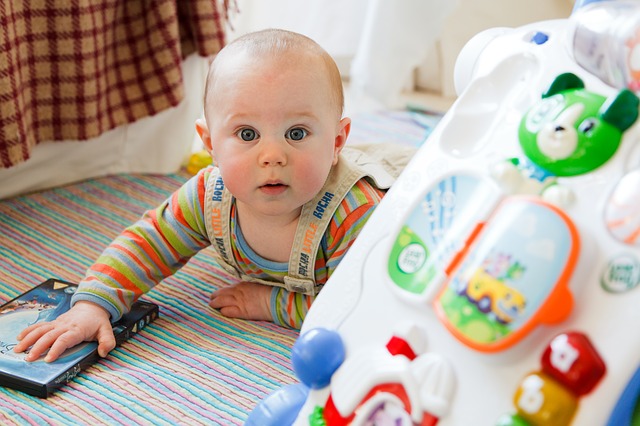Say Goodbye to Positioning Devices
By Nicole Campbell, PT, DPT & Bobbi Michels, PT, DPT
Kids Place West Pediatric Physical Therapists
As a new parent, you will see many different positioning devices as you walk through the baby department of a store. Exersaucers, Jumperoos, Bumbo Chairs, and similar positioning devices are marketed as strengthening devices for your child’s development. But are they really needed?
There is no need to buy these expensive pieces of equipment. The only positioning device you need to optimize your  child’s gross motor development is a safe floor for your child to play on their tummy. When babies are in tummy time, they are able to explore and develop their motor skills.
child’s gross motor development is a safe floor for your child to play on their tummy. When babies are in tummy time, they are able to explore and develop their motor skills.
In a perfect world, babies would spend all of their time doing the following: sleeping on their backs, eating upright, and playing on their tummies. In the real world, parents need time for themselves to perform daily activities such as cooking, cleaning, and showering. So where can you safely keep your baby when holding them or tummy time is not an option? Placing your baby in their crib or playpen are better options than a positioning device.
Studies indicate the two leading causes of head injuries in babies are from using walkers or from falling off baby furniture. Studies also indicate that up to 40 percent of babies are injured during the use of a walker (usually after falling down stairs in the device, tipping over in the device, or even climbing out of the device). In most cases, the parents were present and supervising, but they were unable to act fast enough to prevent the injury.
These devices have also been shown to strengthen the wrong muscles. Studies indicate that motor development is decreased in children who spend a lot of time in positioning devices. When in a walker or standing device, babies rely on the muscles in the back of their legs instead of activating their core muscles or the muscles on the front of their legs. When your child does begin to walk, they will need to know how to use all of their muscles equally, not just the muscles on the back of their legs.
Without the proper development of muscles and balance, there is an increased risk of weakness and tightness which can lead to long-term health risks. At Kids Place, we treat children who walk on their toes. “Toe-walking” causes the foot and calf to shorten and tighten, potentially leading to surgery to release the muscles and realign the foot. We also treat children with muscle weakness at the front of their leg, the hips and the knees, causing many challenges with basic movements like dressing or walking up stairs. Not all children will develop these issues with the use of these types of equipment, but there is increased risk.
If you find you have acquired some of these pieces of equipment, our recommendation is to limit the time your baby spends in equipment. We understand you cannot hold your baby all day. The floor may not always be the best option with older kids or pets around. In Arizona, parents often are afraid their tile floors will cause injuries. Our suggestion: use a pack and go or a playpen. Using these will allow your baby to explore their environment and gain strength and awareness the way we did as children. If you want to use walkers or ExerSaucers, the maximum amount of time per day in any piece of equipment should be 15 minutes.
Please note: you should always supervise your baby closely in equipment to decrease the incidence of an injury. As always, encourage your baby to spend most of their “play” time on the floor sitting, crawling, cruising, and perfecting other motor skill milestones.
References/Sources:
- Kauffman IB, Ridenour M (1977) Influence of an infant walker on onset and quality of walking pattern of locomotion: an electromyographic investigation. Percept Mot Skills 45:1323–1329. MedlineWeb of Science
- Kavanagh CA, Banco L (1982) The infant walker: a previously unrecognized health hazard. Am J Dis Child 136:205–206. CrossRefMedline
- Fazen LE III., Felizberto PI (1982) Baby walker injuries. Pediatrics 70:106–109. Abstract/FREE Full Text
- Stoffman JM, Bass MJ, Fox AM (1984) Head injuries related to the use of baby walkers. Can Med Assoc J 131:573–575. Abstract
- Infant walkers: developmental tool or weapon? Jacquelyn Chamberlin, OTR/L The Children’s Medical Center.
- Chelsea and Westminster Hospital; Promoting Your Baby’s Physical Development; January 2011
- Consumer Reports; Bouncer-Seat Safety; April 2007
- “Child: Care, Health and Development”; Infant Motor Development; A.L. Abbott, D.J. Bartlett; May 2001
- National Institute of Child Health and Human Development; Safe Sleep; August 2009







